Summer of Superman: The Fleischer Classic Cartoons
The Last Son of Krypton is back on the big screen. This latest take on Superman by professed comics fans claims to take the hero back to the core of his mythos; but the character has enjoyed a diversity of interpretations, both in comics revisions and in film or television adaptations that together offer a multifaceted view into the many ways to be a Man of Steel.
This summer, we look back to some of these former takes on ol’ Supes and their unique appeal from the time of their invention, to our present day…
Look, up on the Silver Screen!
It’s September, 1941. Europe’s in the grip of World War II, and America is months away from a notorious surprise attack on Pearl Harbor by imperial Japan. In darkened movie halls, a man dressed in a cape and wrestler shorts sets flight for the great beyond, powered by the sheer force of Fleischer-will.
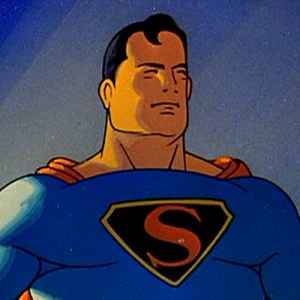
The first superhero
Superman, the first superhero, showed up in commanding form not in the leased back-end funny pages of newspapers, but in his very own bold medium: Action Comics #1, debuting on magazine racks in June of 1938 for a whopping ten cents in newspaper and convenience stores across the nation. That summer, this strange visitor from another planet body-slammed our pop culture with the imaginative impact of “a cave painting waiting to be discovered on a subway wall ten thousand years from now,” in the memorable words of famed comics writer (and punk magician) Grant Morrison. Depicted as a “powerful, at once futuristic and primitive” figure, Morrison’s take on the Action #1 cover portrayal of a “hunter killing a rogue car” hints at an essential appeal this flying strongman tapped, in days when steel frames were sprouting high-rises throughout urban America, while the country continued its shift from an agricultural to industrial economy. Scholar Scott Bukatman nails it when he notes how “superhero comics whimsically presented bodies armored against the shocks of industrialized society.” Here, inside flimsy newsprint, was being revised a template for the new modern man, a fearless action figure who stood up to the non-biological forces rumbling under the metal shell of airplanes and trains, explosively powering bullets and tank artillery, animating electricity. Here was a veritable Man of Steel.
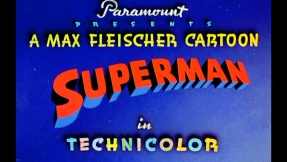
Superman was a hit, readily crossing over into newspapers and AM radio by early 1940, and Paramount studios recognized the character’s larger-than-life aura as an ideal match for cinema and its silver screen dreams. Back then, the movies were the pinnacle in spectacle narrative, tantalizing audience make-belief with the immersive illusion that today, we’re continuing in our own way to mine with 3D popo-ramas and higher resolution film frame rates. The motion pictures were grandiose storytelling projected against a magic curtain that spread far and wide across our field of view, challenging crowded viewers to gather under nocturnal illumination to consider the feats of yesterday and the tales of tomorrow. What better format for showing a man from the stars, at virtuoso play?
The theatrical cartoons
The effects and visual trickery of live-action cinema, while clever and convincing (you’ve heard the drill—trains rushing a frightened audience, cartoon dinosaurs charming matinee children), were still limited by budget and production time. Animated shorts such as Warner Bros.’ Looney Tunes or Merry Melodies, Disney’s Silly Symphonies, the Fleischer Studios’ Betty Boop and Popeye, however, proved enormously successful as lead-ins to feature films. Max and Dave Fleischer, veteran animators who’d invented a new form of life-like animation based on the rotoscope process, were tasked by Paramount to bring Superman into Technicolor motion. What resulted were a series of high quality animated shorts, produced and typically aired every two months between 1941 and 1943—the first nine produced by the Fleischers, the remaining eight produced by their successors after Paramount took over the studio and renamed it to Famous. These theatrical cartoons, with their sophisticated use of background design (it’s an art deco New York on display here, not the fictional city of Metropolis), character shading and crack editing of action sequences, continue to hold up with more charm and alacrity than numerous animated, wire-drawn, or hyper-CGI (including this summer’s Snyderized Supes) attempts to cast Big Blue into the sky, to this day.
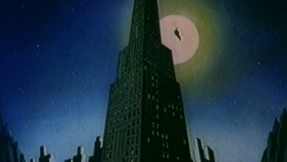
In fact, Superman’s ability to fly was the direct result of these early cartoons. Back in the comics, our hero was still leaping tall buildings—albeit with a single expertly flexed bound from those super calf-muscles. But, leaping buildings looked too awkward in animation, making a hero of Herculean proportion come off more like a super-grasshopper. In cutting lose from the strain of gravity, the Fleischers discovered a depiction of the Last Son of Krypton’s speed and strength that displayed a new kind of vigor. Watch these classic cartoons (they’re all available in the public domain for free online viewing), and you can almost feel the sleek form of this flying man part the air, leaping up and away from invisible footholds to K-O prehistoric monsters and giant robots and deadly death rays and flying cars; you name it, Supes’ll take it. Flight in these cartoons is about jerk and acceleration, with Superman a hurtling body of heedless joy. I can’t think of a comparable feeling other than the Wachowskis’ ingenious depiction of Keanu Reeves as Neo doing his slo-mo pulsing “Superman thing” in the latter two Matrix films. It’s pure elation, grand movie magic.
Lois Lane: intrepid reporter
Typically running at eight minutes apiece, these cartoons tell stripped-down narratives about a threat-of-the-week that the Man of Steel must confront and contain. Barring one episode, Lois Lane—latent love-interest and journalistic competition—always ends up at the center of the action, parking herself in mortal danger by dint of sheer courage, arrogance, utter dumb-assery—maybe a little mix of it all. “What a story this’ll make!” is a typical refrain the reporter offers before climbing into the rear unlocked trunk of a rampaging robot, radioing a newspaper front desk from inside a Nazi stronghold (while dressed like a Klan-like robes and heels), or calling from a phone booth in a museum getting torn a new one by a raging yet dainty-eyed dinosaur. Then there’s the memorable episode where she’s outrunning hired thugs by jumping like Super-Mario from construction girder to construction girder.
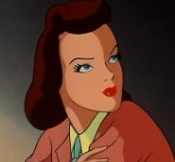
In these cartoons, Lois is no shrinking violet. She’s an ardent and refreshing figure of feminism, her DNA a canny mixture of the no-nonsense protagonist from the comics and hardscrabble tough-as-nails characters such as Rosalind Russell’s Hildy Johnson in His Girl Friday (1940). Despite Clark Kent getting smarter and dapper with each episode—clad in his trademark blue suit and grey fedora—sadly, he’s largely out of the picture in these early cartoons, for the newsroom wit-turned-romantic banter between these two reporters was still being fleshed out in radio. While the comics left little doubt as to the romantic triangle between Lois, Clark and his Superman alter ego, these cartoons, with their economy of time, opt to depict the pair as professional rivals. Lois repeatedly calls shotgun and out-scoops Clark through aggressive initiative (and on one occasion, down and dirty duplicity), leaving our leading man with only a knowing wink or coy smile for the audience at the close of each episode. Even as Lois’ rugged independence leaves mild-mannered Kent blinking in the wake of her clever maneuvering, the stories inevitably undercut her agency by getting her captured and turned into the damsel in distress. Supes must save her from a demented scientist and his pet vulture, a downpour of molten metal, a Japanese firing squad whose commandant struts with an oddly phallic sword, a misdirected surge of lava, etc. Still, the ace reporter has her moments and even offers the occasional assist to Superman, such as when Lois unloads a tommygun on a supercar packed with villains intent on stealing gold from a high-speed train. Her shoulders may rattle as the weapon discharges, but Lois holds her mark.
The Daily Planet newsroom and its supporting characters are only deft touches in these cartoons: you get a dull Perry White as Mr. Exposition, and brief instances of a guffawing sidekick nit-wit who hints at the future invention of Superman’s Best Pal. No Jimmy Olsen here. Lois snaps her own photographs, she’s all in one in these stories.
Robots, mad scientists, hawkmen and Nazis, too
The nine Fleischer cartoons tap into mythic notions of man against uncontrolled science time and again (well, there is the forgettable episode about the monkey that lets loose an angry King Kong-like ape), and this gives way to the latter Famous cartoons’ attention to sub-genres of fantasy. The iconic opening script—it used to be “Up in the sky, look!” in those days, not “Look! Up in the sky!”—comparing the hero to the speed of bullets, the strength of trains, the scale of buildings, gives way to more naturalistic descriptions of man outrunning lightning, besting the power of oceans and hurricanes. Supes fighting primitive Hawkmen inside underground caverns doesn’t feel very Superman. These successor cartoons even take on more ideological, jingoistic perspectives. There are savage depictions of Africans, buck-toothed Japanese spies and soldiers fighting a Superman hell-bent on sinking warships, achtung-bellicose Germans… even an oddly muted depiction of Hitler, turning off the radio in a 1943 short after learning of his uber-defeat by the Superman.
For that matter, the earlier Fleischer works have their own biases, inherited from the comics—it seems scientists and businessmen had a predilection for a life of crime, in the rollicking thirties and forties. But there are more dramatic explorations of Superman’s physicality and limits on display here. Our hero has no heat vision (thank goodness), and while he can punch at electromagnetic beams, tangling with electrical power lines or prying open bulkhead doors proves to be a minor chore.
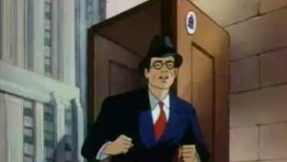
And there are amusing kinks in the iconography, still being worked out in these early experiments with the character: Clark Kent ducks into a classic public payphone or the ubiquitous storage closet for a quick-change to Superman, and we behold in outline a rather awkward striptease—composer Sammy Timberg’s triumphant trumpets soaring—as the Man of Tomorrow assiduously gets down to removing both shirt and pants.
A class act
All said and done, the Fleischer/Famous Superman cartoons are classic works that convey, in fluid motion, the fantastic power and speed of a demigod, without overwhelming its human audience’s sensory perceptions. And unlike this summer’s Superman telling, the slugfests here are dealt with a cool economy that is, really, innately heroic: Superman is here to protect us, and his presence hinders catastrophic attacks against our cities, it doesn’t precipitate them. The lessons in heroic action these animated shorts offer were as pertinent in the 1940s as they are today: contain the threat, watch out for collateral damage threatening innocents, defeat the opponent with as little violence as possible. And always keep an eye or ear open to track what Lois is up to. This is the sort of Man of Tomorrow we might aspire to soar alongside. A calculating protector who valiantly keeps buildings from falling over at all costs, as opposed to, let’s say, a version whose careless slugfests might decimate downtown, and cap said madness with a half-hearted emo-scream at the local train station… The Fleischer Superman’s got a little more self-control and competency than that, and despite their latter narrative shortcomings, these cartoons largely offer a class act on how to conduct the Neverending Battle with style, and grace.
Five episodes worth checking out
Most of the Fleischer and Famous Superman cartoons are worth the time to check out. In particular, here’s five memorable episodes to sample for a sense of this oft-forgotten take on the original superhero.
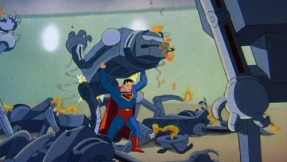
Superman (Sept. 26, 1941) / The Mechanical Monsters (Nov. 28, 1941): Take your pick from either of these definitive episodes kicking off the Fleischer run. Superman sets up Kal-L from Krypton’s origin story with great economy (this version of the hero grows up in an orphanage, no Ma and Pa to help flesh out his Clark Midwesterner identity) and shifts gears to a New York threatened by an evil scientist sporting sanitarium pajamas and weird two-piece receding Mohawk. Watch Supes beat back the dreaded electrothanasia ray with his mighty fists and save the day. Alternately, The Mechanical Monsters pits our hero against lurching giant robots terrorizing and stealing on behalf of a mustachioed evil genius; naturally, Lois gets into the fray, as well. The episode is cited as a personal inspiration of anime master Hayao Miyazaki, and sports a terrific smackdown scene between the Man of Steel and the metallic monstrosities.
The Arctic Giant (Feb. 27, 1942): A dinosaur is found intact in the Antarctic, encased in ice, and triumphantly brought back to New York for public display. Naturally, something goes wrong, in one of the more hilarious sequences portraying a tiny workplace blunder leading to mega-catastrophe. Dino’s on the loose, wrecking the city at large, and it’s a job for you-know-who to save the day. Man against monster, in classic form.
The Bulleteers (March 27, 1942): A trio of devious scientist or engineer types with New Yawk accents threaten the city by riding high in the ultimate transformable vehicle—now it’s car, now it’s a, um, flying bullet. It’s exciting to see Lois almost singlehandedly sabotage the nifty auto, but ultimately Superman must take to the skies in some of his most dynamic depiction to date, and put down the Bulleteers nefarious plans to riddle the cityscape fulla holes.
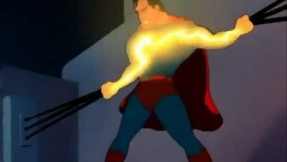
The Magnetic Telescope (April 24, 1942): In a more unusual take on the perils of the science man, Superman must intervene when a careless scientist insists upon drawing an unpredictable comet towards the city, using his giant horseshoe magnet. It’s noteworthy to see here an instance of super-muscles proving inadequate against a heavenly object, prompting our hero to exercise some clever thinking and re-purpose that magnet to save the city. See, science ain’t always the enemy. An inspiring scenario that goes on to become an oft-repeated theme in latter Superman televisions shows, and even shows up in an alternate form in the Bryan Singer-directed film.
Japoteurs (Sept. 18, 1942) / Eleventh Hour (Nov. 20, 1942): These two notorious Famous Studios entries dish out propagandistic and racist depictions of the Japanese, while hypocritically proffering a heroic take on the Man of Tomorrow as the saboteur of today. America was intensively fighting alongside its allies in the Second World War during these productions, and you see the concerns and double-standards of the time expressed in these two companion shorts in some heavy-handed jingoism. The pejorative conjunction in the title of Japoteurs says it all; and if you still don’t get it, Lois spells it out with an ugly slur while trying to foil the theft of a new warplane by Japanese spies. In Eleventh Hour, Clark and Lois are on an unexplained assignment to Tokyo, where our hero repeatedly switches to his superhero tights to wreck Japanese warships berthed in their dockyards (with naval personnel aboard some of them, you have to wonder?). Either of these episodes offer provocative examples of how a comics icon can be repurposed, and are more of interest now as historical artifacts from another era.
What do you think? Leave a comment.



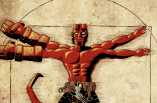
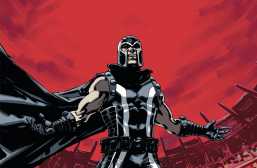
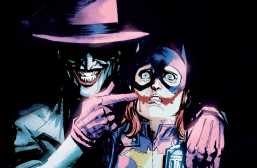

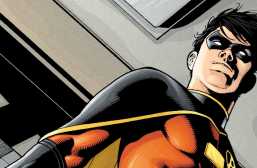

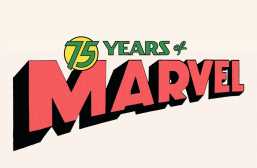
Very nice article.
I love the fact that the studio did not actually want to do them in the first place. When they were asked by DC/National/Paramount to do them, the Fleischers made up a crazy expensive quote for what they would charge, thinking that they would not have to produce them.
The studio execs didnt even blink and signed off on them.
Now we have these wonderful shorts forever!
Glad you liked the article, thanks so much. That’s a great story about the Fleischers purposely overestimating their production cost, but Paramount was so intent on setting up this gravy-train, they agreed without argument. Sure enough, the high animation quality that resulted has really stood the test of time!
In my humble opinion, these Fleischer cartoons represent not only the best of the Fleischers’ extensive body of work, but for me, they’re the only true Superman. When I hear that wonderful theme, trumpets blaring and blazing, I sink back into being a little kid, gazing up with wonder at Superman’s next big adventure, fighting this, that, or the other baddie, and saving Lois Lane, while Clark Kent always conveniently disappeared! It’s a wonder he never got fired from the Daily Planet, the way he always disappeared while Lois and Jimmy were getting the big scoop and getting saved by Superman!
I also strongly recommend checking out Robb Pratt’s retro “Superman Classic” series on YouTube (he’s done two very short episodes). Robb’s a hardcore fan of the Saturday matinee Superman serials (starring Kirk Allen), but his cartoons smack of the sort of energy in these Fleischer/Famous cartoons. Remarkably, Robb does all the animating by himself. Impressive effort!
The Arctic Giant is the best Superman cartoon ever (Mechanical Monsters being a close second). It is very refreshing to see my favorite superhero in a situation where his powers are actually useful — without inventing any ridiculous powers.
A giant dinosaur getting beaten up by Superman + great animation = BEST SUPERMAN CARTOON EVER. HOw can you not agree!
Indeed, tough to beat!
Thank you for the post! It’s sort of amusing to see Lois always being captured and tied up in these cartoons.
Some shameful racism in Japoteurs, but other than that, it is a decent SM cartoon. It could appeal to anyone interested in World War II propaganda.
By the way, Man of Steel, very disappointed, but far superior to Superman Returns.
Love Fleischer Studio and its so-called “New York Style”. Thanks so much for your inspiration, I’ m writing an article on Betty Boop now 🙂